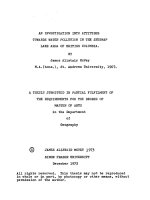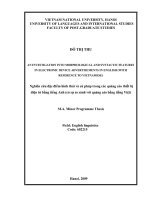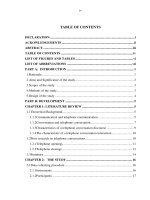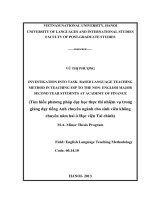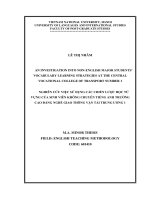An investigation into nominalization and grammatical metaphor in ‟happy teachers change the world‟ by thich nhat hanh and katherine weare”
Bạn đang xem bản rút gọn của tài liệu. Xem và tải ngay bản đầy đủ của tài liệu tại đây (137.73 KB, 25 trang )
THE UNIVERSITY OF DANANG
UNIVERSITY OF FOREIGN LANGUAGE STUDIES
GIÃ THỊ TUYẾT NHUNG
AN INVESTIGATION INTO NOMINALIZATION AND
GRAMMATICAL METAPHOR IN” HAPPY TEACHERS
CHANGE THE WORLD” BY THICH NHAT HANH AND
KATHERINE WEARE
Major: ENGLISH LINGUISTICS
Code: 822.02.01
MASTER THESIS IN
LINGUISTICS AND CULTURAL STUDIES
OF FOREIGN COUNTRIES
(A SUMMARY)
Da Nang, 2020
This thesis has been completed at University of Foreign Language
Studies, The University of Da Nang
Supervisor: Assoc. Prof. Dr. Phan Văn Hòa
Examiner 1: Trương Bạch Lê, Ph.D.
Examiner 2: Nguyễn Hữu Quý, Ph.D.
The thesis was be orally defended at the Examining
Committee Time: 3rd July 2020
Venue: University of Foreign Language Studies
-The University of Da Nang
This thesis is available for the purpose of reference at:
- Library of University of Foreign Language Studies, The
University of Da Nang.
- The Center for Learning Information Resources and
Communication - The University of Da Nang.
1
Chapter One
INTRODUCTION
1.1. RATIONALE
According to David Crystal (2007) ―Language as an
instrument of thought and people feel need to speak their thoughts
aloud‖ and "Happy Teachers Change The World" written by Thich
Nhat Hanh and Katherine Weare (2017) is a clear and convincing
evidence for above messages.
However, to have a deep comprehension and full
understanding of the book, the readers have some inevitable
difficulties. What makes this book become concise and offers book
its own functional meaning? With a glimpse at every page of the
book, we can recognize the two main impressing ways in usage of
language: Nominalization and Grammatical Metaphor (GM).
Nominalization is ―the single most powerful resource for creating
GM‖ (M.A.K Halliday & Mathiessen, 2004). It is usually considered
as a part of GM, but in fact Nominalization has it own properties that
are different from GM.
There have been many excellent studies on GM and
Nominalization but there are not any studies in the combination of
the two phenomena in the same book. The writer chose the two
phenomena: Nominalization and GM including Ideational GM,
Interpersonal GM and Textual GM as the official tools to analyze the
book.
As a result, on the basis of the results of the previous studies,
I would like to deal with the research title: «An Investigation into
Nominalization and Grammatical Metaphor in ‗Happy Teachers
Change The World‘ by Thich Nhat Hanh and Katherine Weare».
2
1.2. AIMS AND OBJECTIVES
1.2.1. Aims of the study
- Investigate the types and the functions of NML in the
book―Happy Teachers Change The World‖ by Thich Nhat Hanh and
Katherine Weare.
- Investigate GM including Ideational, Interpersonal and
Textual ones used in‖ Happy Teachers Change The World‖ by
Thich Nhat Hanh and Katherine Weare.
- Find out the evidences to solve the research questions
related below.
- Make a contribution to answer the question ‗what makes
the book‖ Happy Teachers Change The World‖ interesting
linguistically?
1.2.2. Objectives
- Investigating and analysing the ways of expressing NML in
―Happy Teachers Change The World‖ by Thich Nhat Hanh and
Katherine Weare‖ including identifying semantic and syntactic
features of NML and its functions.
- Investigating and analysing the ways of expressing GM in ‖
Happy Teachers Change The World‖ including Ideational,
Interpersonal and Textual ones, mainly from the functions of NML.
1.3. RESEARCH QUESTIONS
1. What are the types and the functions of Nominalization
used in the book‖ Happy Teachers Change The World‖ by Thich Nhat
Hanh and Katherine Weare?
2. How are Ideational GM, Interpersonal GM, and Textual
GM expressed through Nominalization in the book‖ Happy Teachers
Change The World‖ written by Thich Nhat Hanh and Katherine
Weare?
3
1.4. SCOPE OF THE STUDY
This study investigates NML and GM including Ideational,
Interpersonal and Textual ones appearing in terms of words, phrases
and clauses in the book ―Happy Teachers Change The World‖ by
Thich Nhat Hanh and Katherine Weare. The analysis mainly follows
Halliday‘s work ―An Introduction to Function Grammar‖ by
Halliday (1985, 2004, 2014) and function-oriented others as the
framework although NML and GM from cognitive linguistics are, in
the first time of researching, used to be suggested to investigate.
1.5. SIGNIFICANCE OF THE STUDY
By analyzing NML and GM, the researcher hopes to
contribute to understanding the expressions and the functions of
NML and GM in linguistic in general. In particular, the findings of
the study, to some extent, can provide more evidence from NML and
GM to understand texts more deeply and practise writing in a better
way. Besides, the thesis provides some updated information and
necessary knowledge for those who are interested in discovering and
learning NML and GM from the framework of Functional Grammar.
4
Chapter Two
LITERATURE REVIEW AND THEORETICAL
BACKGROUND
2.1. A REVIEW OF PREVIOUS STUDIES
Nominalization and GM have been so far researched by
many researchers such as in the world: Cassin L. Liardet (2016) in
the article ―Nominalization and GM: Elaborating The Theory‖ and
in Viet Nam: Phan Văn Hòa (2008) in ‖ Ẩn dụ,ẩn dụ học và ẩn dụ
ngữ pháp‖,etc. However, the questions of what the types of
Nominalization are used and how Ideational G.M, Interpersonal GM,
and Textual GM are expressed through Nominalization in the book‖
Happy Teachers Change The World‖ written by Thich Nhat Hanh and
Katherine Weare in Functional Grammar introduced by Halliday
have not been dealt with considerably.
2.2. THEORETICAL BACKGROUND
2.2.1. Functional Grammar
For Halliday, grammar is considered to be systems not as
rules, on the basic that every grammatical structure involves a choice
from a describable set of options. Therefore, language is a meaning
potential. He claims that language is met functionally organized. All
languages have resources for construing experience (ideational
function), for enacting human‘s diverse and complex social relations
(interpersonal function) and for enabling these two kinds of meaning
to come together in coherent text (textual function).
2.2.2. Nominalization
In linguistics, nominalization is the use of a verb, an
adjective, or an adverb as the head of a noun phrase, with or without
morphological transformation. ().
2.2.2.1. Simple Nominalization (Lexical Nominalization)
5
a. Action/state nominalization.
Most languages of the world make use of one or more
devices for creating action nouns from action verbs and state nouns
from stative verbs or adjectives, e.g. create —> creation, drive a
truck —> truck-driving,
b. Agentive nominalization
The suffix -er derives nouns meaning ‗one which ―verbs‖‘
from both agentive and nonagentive verbs, e.g. sing —> singer.
c. Instrumental nominalization
d. Manner nominalization
The action noun is indeterminate between a fact/occurrence
interpretation and a manner interpretation, e.g. his walking can refer
either to the fact or occurrence of his walking or to the way he walks
e. Predictability and productivity
Almost any polysyllabic verb ending in -ate will form its
action noun by adding -ion, as in create/creation
2.2.2.2. Complex Nominalization (Syntactic
Nominalization) without Grammatical Metaphor
a. Combine clauses with THAT or THE FACT THAT and
words starting with wh-: WHAT (EVER), WHEN (EVER), WHO
(EVER), WHO (EVER) and HOW.
According to Zeno Vendler, to transfer from a sentence or
clause to nominalization with THAT, it must have the following
structures:
b. Derivative verbs of propositions into nouns: nominalized
by adding –ING to verbs.
e.g. The fact that I denied what he accused me of impressed
the jury.
-> In denying his accusations, I impressed the jury.
6
2.2.3. Grammatical Metaphor
2.2.3.1. Metaphor in general
According to Halliday (1985), Metaphor is a verbal
transference; a variation in the expression of meanings which
involves a non- literal use of a word. In particular, Metaphor is an
irregularity of content that consists on the use of a word in a sense
different from its proper one and related to it in terms of similarity,
e.g. The sky is crying.
2.2.3.2. Grammatical Metaphor
Grammatical metaphor is conceived as an incongruent
realization of a given semantic configuration in the lexicogrammar
(Halliday 1985)
+ Ideational Metaphor
Halliday (1994:343) claims that the ideational metaphor is
metaphor of transitivity. It is the grammatical variation between
congruent
and incongruent forms.
+ Interpersonal Metaphor
Interpersonal GM in general is organized in two types,
metaphors of mood and metaphors of modality.
In the system of modality, Modality refers to how we express
our evaluation about the likelihood that something will take place in
reality.
In the system of mood, Halliday describes metaphors of
mood in a similar way as metaphors of modality: in this type of
interpersonal metaphor, a mood meaning is not expressed in the
clause, but rather as an explicit element outside the clause.
+ Textual Metaphor
Textual metaphor, according to Martin (1992: 416), is a
7
useful term ‗when discourse systems are used to construe text as
―material‖ social reality‘. Martin identifies four types of textual
metaphor: meta-message relation; text reference; negotiating texture;
and internal conjunction.
8
Chapter Three
RESEARCH DESIGN AND METHODOLOGY
3.1. RESEARCH
The study focuses on description, classification and analysis
of function‘s NML and GM from Functional Grammar Perspective.
To achieve those aims, the main methods are descriptive, qualitative
and quantitative. These methods help the study describe, demonstrate
and analyse the types of Nominalization, how NML, Ideational
Metaphor, Interpersonal Metaphor and Textual Metaphor work. The
book ―Happy Teachers Change The World‖ by Zen Master Thích
Nhất Hạnh and Educator Dr. Katherine Weare, is used as the source
of data collected and the evidences for the existence and the
Functions of NML in Non – GM and GM cases.
3.2. SAMPLING
Based on the achievements from the studies of NML and
GM, the thesis writer determines the standards to select samples
involved in NML and GM. In this way, 507 samples which are
words, phrases and clauses using NML and GM were collected in the
book
3.3. DATA COLLECTION
1. Understanding the text (book) by reading (many times) in
terms of form and content;
2. Focusing on the ways of creating the text, especially in
writing;
3. Depending on the selected criterion to observe possible
patterns of sample as Nominalization and GM expressions;
4. Getting samples;
9
5. Finally, checking samples collected to see if they are
satisfactory for the selected criterion.
1
s
2
s
s1
m
semantics
lexicogrammar
c
phonology
s – semantic choice
c – congruent form
m – metaphorical form
Figure 3.1. Grammatical metaphor interpreted as semantic
compound (According to Ravelli, 1985)
3.4. DATA ANALYSIS
The words, phrases and clauses in the book with the
appearance of NML, Ideational Metaphor, Interpersonal Metaphor
and Textual Metaphor will be chosen. They are then analyzed and
classified to find out the existence and the functions of NML in Non
– GM and GM cases, which bases on Halliday‘s theory.
3.5. PROCEDURES
The procedure for the study will be as follows:
- Surveying preliminarily some aspects related to the
linguistics to seek the research problem.
- Identifying the problem and reviewing the literature to
come to the decision for the focus of the research.
- Collecting samples which are words, phrases and clauses
with the appearance of NML and GM from the book ―Happy
Teachers Change The World‖.
10
- Describing how NML, Ideational Metaphor, Interpersonal
Metaphor and Textual Metaphor used in those samples according to
The Function Grammar Perspective.
- Analyzing to find out the types of NML, NML in Non –
GM and GM cases in the book.
3.6. RELIABILITY AND VALIDITY
In terms of reliability, the source selected to be investigated
is derived from the book ―Happy Teachers Change The World‖,
therefore, the data source is highly reliable. Moreover, the findings
and conclusions in the study are drawn from the analysis of
frequency of samples, statistics and proofs concerned without any
prejudices or presuppositions. For this reason, the objectivity of the
study is assured.
In term of validity, this study meets all required criteria. In
order to answer two research questions, the observation and
investigation techniques have been chosen to be the main
instruments for data collection. Besides, the investigation must
follow the research design and the principles of theory presented in
chapter 2 strictly to obtain the quality and to guarantee the validity
and reliability of this study.
11
Chapter Four
FINDINGS AND DISCUSSIONS
4.1. NOMINALIZATION TYPES USED IN “HAPPY
TEACHERS CHANGE THE WORLD”
4.1.1. Simple Nominalization
4.1.1.1. Nominalized Verbs
+ Suffix-derivation
- The
affixes -ance, -al, - age, -ence, -action, - ion, -sion, -tion, ution,
-ing, -ment, - ure… are used to form a nominalization of
action, state or process.
(1) nourish -> nourishment
[p.41]
- The affixes: -er, -or, -ee, - ar, -ent, -ant … are used to refer to the
person or instrument.
(2) teach -> teacher
[p.3]
+ Zero-derivation
- Conversion
(3) The effect of this practice can be very deep.
[p.4]
- Final syllable shift
(4) speak -> speech
4.1.1.2. Nominalized Adjectives
[p.169]
Using suffixes
Suffixes of this type, or de-adjectival nominalisers can be found, for
example, with–ness to kind to create the corresponding noun
(5) kind-> kindness
[p.42]
4.1.1.3. Nominalized Adverbs
(6) Here-> the here
4.1.1.4. Noun→ Adjective→ Noun
[p.42]
(7) Mind-> mindful-> mindfulness
[p.42]
4.1.1.5. Verb → Adjective → Noun
12
(8) Interconnect-> interconnected-> interconnectedness
4.1.2. Complex Nominalization
4.1.2.1. Complex Nominalization in Phrase
+ Gerundive nominals
- A/ The + Gerund + of-Phrase
(9) There is a feeling of satisfaction being....
[p.128]
[p.xx]
- Prep + the + Gerund + of-Phrase
(10) ......sit quietly and breathe at the beginning of each class. [p.55]
+ Derived nominal
(11) After that, I invite the students to drink the glass of water
mindfully, and to get in touch with their sensations, with the
freshness of the water, to taste it just like if it was the first time they
drank.
[p.252]
4.1.2.2. Complex Nominalization in
Clause + Clause with THAT
Complex Nominalization within clause usually goes with THAT and
THE FACT THAT. According to Zeno Vendler, to transfer from a
sentence or clause to nominalization with THAT, it must have the
following structures: (n: nominal)
(12) That mindful eating sometimes includes some periods of silence
can sound oppressive if you haven‘t experienced it.
[p.126]
+ Words that begin with WH(13) Whoever teaches mindfulness has to have a .......
[p.285]
4.1.3. Summary of Nominalization
13
Table 4.13. Types of Nominalization
Types of
NML
Simple
Form
Occurrence
Rate
V→ N
101
Adj→ N
39
Adv → N
2
N →Adj → N
1
V →Adj → N
1
Gerundive
nominal
79
Derived
nominal
23
+ Clause with
THAT
10
+ Words that
begin with
WH-
7
Word
54,5%
NML
143
Phrase
Complex
NML
Clause
Total
119
262
45,5%
100%
4.2. GRAMMATICAL METAPHOR EXPRESSED THROUGH
NOMINALIZATION IN” HAPPY TEACHERS CHANGE THE
WORLD”
4.2.1. Ideational Grammatical Metaphor
4.2.1.1. Nominalization in
clause + Nominalization of the Process
14
The process is realized by a finite verbal group. The Event in
the process is transferred into the Thing in a new nominal group with
other components of the original clause disappearing or becoming
the modifying part in the nominal group
- In the relational process
- In the behavioral process
- In the material process
- In the mental process
- In the verbal process
+ Nominalization of the circumstance
+ Nominalization of the attribute
An attribute is considered as some entity; as a quality; as a
circumstance of time, place or as a possession in the relational
process. In other words, an attribute can be realized by adjectival
groups, prepositional groups or nominal groups. For example (The
Grammar of English Grammars/Part II)
4.2.1.2. Nominalization below the clause
The phenomenon of nominalization occurring below the
clause just happens to nominal group that function as a participant in
the clause. It is called ―the phenomenon of nominalization of the
Epithet‖, which means it is contained in a nominal group. Moreover,
the Epithet here is most of the adjectives which are particularly
attribute adjectives and some adjectives that are both attribute and
predicate
(14) I still have moments of sadness, but one I detect it, I can
embrace my sadness mindfully and create an increasingly freer space
inside.
[p.154]
4.2.1.3. Nominalization above the clause
15
The phenomenon of Nominalization Above the Clause
means the functional- semantic relations between clause, clause
complexes or some longer stretches of discourse are turned into a
noun or a nominal group. A clause is connected with other clauses
with the use of relators, such as coordinating conjunctions: for, and,
but, or, yet, so and subordinating conjunctions: because, if, when,
although.
(15) The purpose of meditation is not to feel good, although we
secretly hope that will be a result.
[p.45]
4.2.2. Interpersonal Grammatical Metaphor
According to Halliday (2014) Interpersonal metaphor
consists of metaphors of modality and mood.
4.2.2.1. Metaphor of Mood
Metaphor of Mood is understood as exchanging commands
and making requests.
+ Commanding
(16) Can I ring them?
[p.37]
+ Offering
(17) Would you like me to tell you what I did...?
[p.41]
+ Promising
(18) They promised not to criticize their children back home for
misspelling or mistakes they are allowed to take a look at their
notebook.
[p.238]
4.2.2.2. Metaphor of Modality
Modality metaphor is the realization of a degree of certainty
via modal elements that do not occur within the clause but are added
to the initial clause
+ Probability
+ Obligation
16
4.2.3. Textual grammatical metaphor
According to Martin (1992: 416), textual metaphor is a
useful term ‗when discourse systems are used to construe text as
―material‖ social reality. From the point of view of lexical relations
Winter's (1977) Vocabulary 3 items and Francis's (1985) A-nouns
(e.g. reason, example, point, factor) organise text, not field. Text
reference identifies facts, not participants, and internal conjunction
orchestrates textual not activity sequences. Negotiation can also be
exploited to construe monologic text as dialogue.
(19) I also know that students have taken this practice and used it at
home to help themselves- for example, when they are feeling
agitated or they can‘t sleep.
[p.55]
4.2.4. Summary of Grammatical Metaphor
Table 4.31. Types of Grammatical Metaphor
Types
of GM
Form
NML
In Clause
GM
Rate
Process NML
102
Circumstance
NML
4
Attribute NML
9
NML
Below
Clause
Epithet
12
NML
Above
Clause
Conjunction
3
Metaphor
of Mood
Commanding
30
Ideation
al
Occurrence
130
53,1%
17
Types
of GM
Interper
sonal
GM
Metaphor
of
Modality
Form
Occurrence
Offering
18
Promising
19
Probability
13
Obligation
9
Meta-message relation
Textual
GM
36,3%
2
Text reference
4
Negotiating texture
8
Internal Conjunction
12
Total
89
Rate
26
245
10,6%
100%
18
Chapter Five
CONCLUSION
5.1. CONCLUSION
With a glimpse at every page of the thesis, we can recognize
the two main impressing ways in usage of language: NML and GM.
NML has its own properties that are different from GM. In other
words, NML happens at the level of lexicogrammar to create
linguistic expressions from which their functional interpretation can
be congruent or/and metaphorical. This is the reason why NML is
also a part of GM. It is the most powerful tool for creating GM in
general and for creating ideational, interpersonal and textual GM in
particular. This thesis has investigated the types of NML and their
functional ways of expressing GM: Ideational GM, Interpersonal
GM, and Textual GM. NML is divided into two types: Simple NML
and Complex NML. Especially, the thesis has focused on
emphasizing NML in Non- GM and GM cases to make clear the
relationship between NML and GM.
In theory, the analysis and explanations of the thesis are
based mainly on the functional grammar perspective as the
theoretical framework by Halliday.
In practice, the book ―Happy Teachers Change The World‖
by Zen Master Thích Nhất Hạnh and Educator Dr. Katherine Weare,
is used as the source of data collected and the evidences for the
existence of NML and GM which extracted for quantitative and
qualitative analysis, shed light on our understanding of those two
phenomena.
The investigation shows that NML and GM take a large
number in the book involving 507 samples with many types: NML
accounts for 262 samples in which Simple NML is 143 samples and
19
Complex Nominalization occupies 119 samples. Grammatical
metaphor has 245 samples, in which Ideational GM is 130 samples,
Interpersonal GM is 89 samples, and Textual GM is 26 samples.
Through the investigation, the definitions of the terms involved are
clearly explained in the thesis.
In NML in general, the research focuses on three types of
NML viewed as constructions of their own: They are
reclassifications of non- nominal into nominal units or units which
have adopted nominal functions both in their external and internal
functioning. It means that Nominalizations appearing in the book are
analyzed in both Lexicology and Syntax.
Firstly, an accurate description of these nominal units
involves a description of their symbolic status (as units which encode
a particular meaning or Simple NML). Secondly, the compositional
relationships which they realize (of their component functions or
Complex NML) are also described. Thirdly, the relationships in
which complex categories of NML Function as GM are depicted.
In GM, there are three types GM analyzed: Ideational GM,
Interpersonal GM and Textual GM.
In the case of Ideational GM, the thesis focuses on NML
because this is the powerful source of GM. It is very clear that NML
is formed by using suffixes or even combining various prefixes and
suffixes. As discussed in chapter 4, Nominalizing happens below the
clause, in the clause and above the clause. Below the clause, NML
occurs when a part of the clause- the Epithet in the nominal group is
turned into a noun. The Epithet is realized by attribute adjectives.
When being nominalized, the Epithet is often accompanied by a
preposition. Above the clause, NML is relators nominalized by using
another noun or nominal group. In the clause, Nominalization occurs
20
in the process, in the attribute and in the circumstance. Actually, in
NML of the process, the Event in the process realized by a finite
verbal group is transferred into the Thing in a new nominal group.
NML of the attribute is NML of Adjective in the relational process
functioning as an Attribute. By means of NML, the attribute is turned
into a thing. In the circumstance, manner adverbs are transformed
into a noun or nominal group that becomes the Head or Thing in a
new group. NML in the circumstance only occurs when a verb in the
clause modified by an adverb and that adverb is then turned into a
noun. The clauses in the paragraph are connected with each other by
conjunctions or relators. In these cases, nominaling above the clause
turns these conjunctions or relators into nouns without changing
much the basic meaning. Besides, NML plays the role as a cohesive
device which is used to replace a part of the clause or the whole
clause by a noun or a nominal group.
With the case of Interpersonal GM, the writer analyzes two
aspects: Metaphor of Mood and Metaphor of Modality. Metaphor of
mood happens when there is the transference from this mood into
another one in a clause. Therefore, a text creator can choose different
expressions depending on his or her purpose to express the same
meaning.
Metaphor of mood has two central characteristics: Firstly,
they are based on the relationship between the speech functional
categories of «statement, question, command and offer» and the
expression of these categories through different mood types.
Secondly, the distinction between an exchange of information and an
exchange of good and services plays an important role in the
recognition and definition of this kind of GM.
21
Metaphor of modality expresses modality outside the
sentence. It is an explicit realization of modal meaning. With this
kind of this metaphor, a projecting clause is involved if modality is
expressed metaphorically, which usually has a word or proposition to
indicate probability, usuality, likelihood, certainty or other features
connecting with modality. Metaphor of modality encourages people
to use the grammar metaphorically. People can say I think, when they
mean probably; or I believe, when they mean almost certainly; or
don’t you think, when they mean definitely. In Interpersonal GM,
NML is less negotiable than clauses.
In the case of Textual GM, the transcategorization in Textual
Metaphor from conjunction through preposition to zero linker is in
consistency in direction with the rank- shift in Ideational Metaphor.
While the transcategorization in Textual Metaphor from preposition
to zero linker is reserve in direction to the rank- shift in ideational
metaphor and therefore NML in this type also seldom appears.
The transferences in the three types of GM are all
unidirectional, diachronically interrelated, but each has its own
characteristics.
To sum up, the phenomena of NML and GM are the
representation of meaning through a shift from one grammatical
form to another (Halliday, 2009). Establising the form and function
of Processes, Participants and Circumstances gives us the
metalanguage to label not only the components of content, but make
explicit the grammatical shifts that typically occur in paraphrasing.
The analysis of grammatical changes in NML and GM manifest
in successful paraphrases. In such a case, it helps to peek into the
process of paraphrasing to see how the conponents interact with one
another in typical shifts and features functioned in academic
22
discourse. Analyzing GM as a key phenomenon of academic writing
helps students recognize when it happens and /or when it is needed
through the duration of the course. A list of typical metaphoric shifts
provides English learners with an expanded toolkit to deploy and
build upon through their academic English language development.
That is also the content of the next part I will focus on.
5.2. IMPLICATIONS
5.2.1. Implication for teachers
Teachers can apply GM to help their learners improve their
formal writing and other skills. Teaching NML and GM is one of the
processes that help students make acquaintance with formal texts,
providing them with some knowledge to improve their English
learning skills. Teachers should emphasize the importance of NML in
English and notice that students will encounter NML and GM at all
levels of school. The higher class they are in, the more frequently
they encouter GM because NML and GM appear mostly in adults‘
language, especially, in formal writing.
Moreover, teachers can provide some common patterns and
give the exercises to practice.
5.2.2. Implication for learners
Learners should be aware that languages have different ways
with various structures to express the same meaning. NML and GM
are two typical phenomena which appear in word, phrase or clause of
a text. In order to understand a text, one of the most important things
that learners need to understand is sentence structure.To understand
it, they need to understand the use of a verb, an adjective, an adverb
or a phrase in a united structure in functional expressions : congruent
or/and incongruent in terms of semantics and pragmatics. Learners
should know how to analyze the phenomena of NML and GM. From
23
doing so, they can to improve their writing and understanding
English texts, especially more formal texts like scientific ones. In
this sense, it is clear that linguistic knowledge including NML and
GM is not only necessary for knowledge itself but also useful for
using language effectively.
5.3. LIMITATIONS OF THE THESIS AND FURTHER STUDY
5.3.1. Limitations of the thesis
There are some limitations in the study:
- First, the study is limited to NML, Ideational GM,
Interpersonal GM, Textual GM used in book ―Happy Teachers
Change The Word‖ only. In fact, these kinds of NML and GM are
used in several fields such as in academic discourse, in legal
discourse, in advertisement, in newspapers etc.
- Second, this study does not do the contrastive analysis of
NML and GM between English and Vietnamese to distinguish the
similarity and difference of this phenomenon from two languages.
- Third, NML, Ideational GM, Interpersonal GM, Textual
GM are investigated in the Functional Grammar Perspective and the
data collected are only from one book. They can be analyzed
carefully and deeply in Cognitive Linguistics and with a greater
number samples from many sources.
5.3.2. Suggestions for Further Researches
Further researches are suggested to investigate NML and
GM more deeply and more diversely from multiperspectives or
monoperspective, especially from cognitive linguistics. It may be
interesting to analyze to point out the similarities and differences of
NML and GM between the two languages.


